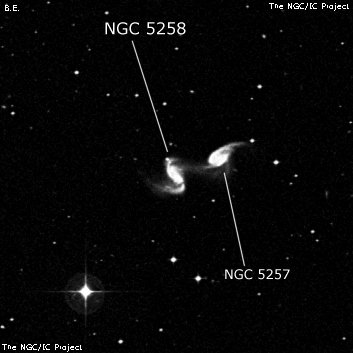
William Herschel discovered NGC 5258 = H II-896 = h1655, along with NGC 5257, on 13 May 1793 (sweep 1044) and noted "F, S, iR." JH called it the larger of the pair, but both were "vF; R; bM."
On 24 Apr 1857, R.J. Mitchell (LdR's assistant), recorded "the p one NGC 5257] is slightly oval in form and the f one [NGC 5258] is mE nearly north-south and has a star at n end. Both look very resolvable. No nuclei, not vF." A sketch made on 26 Apr 1878, shows NGC 5258 as having an irregular shape (like a flying bat) and concave to the east.
400/500mm - 17.5" (4/28/90): fairly faint, fairly small, elongated 5:2 SSW-NNE, brighter along the major axis. Located 4.2' NW of mag 9.5 SAO 120058. NGC 5258 has a slightly higher surface brightness than its close companion NGC 5257, just 1.5' WNW.
900/1200mm - 48" (5/4/16): at 610x; bright, fairly large, two-armed spiral that is interacting with NGC 5257. The main body is elongated 3:1 SSW-NNE, 1.1'x0.35', and is well concentrated with a fairly small, roundish, brighter core. A mag 15.5 star is at the NNW edge and an apparent HII region is visible midway between the core and this star, along the major axis. A strong spiral arm is easy visible attached to the southwest end. It hooks sharply to the east and gradually fades, stretching 40"-45" E. A dim shorter arm is attached on the northeast end and curls west near the mag 15.5 star, extending perhaps 20" in the direction of NGC 5257.
Notes by Steve Gottlieb